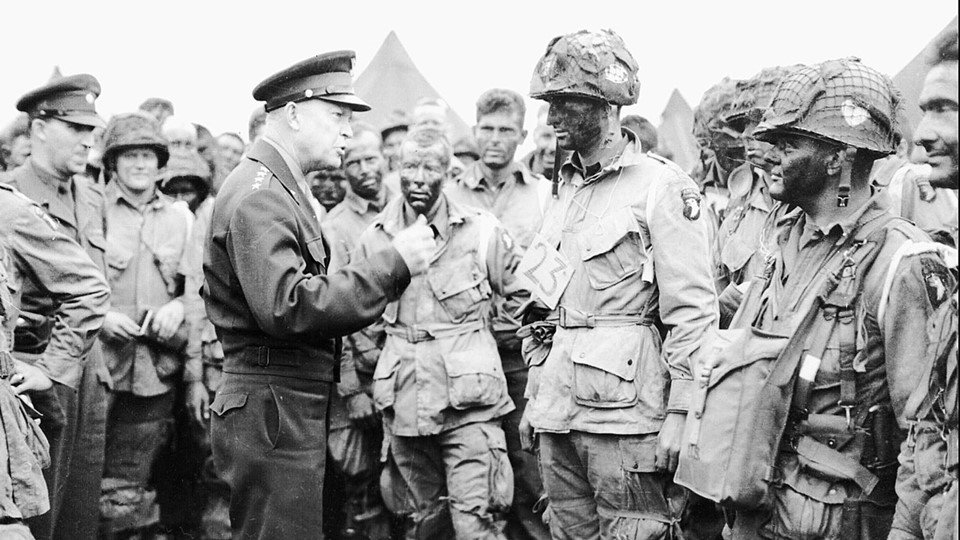Uncle Sam’s Men, Our Heroes: The U.S. Infantry
“The rifleman fights without promise of either reward or relief. Behind every river there’s another hill—and behind that hill, another river. After weeks and months in the line only a wound can offer him the comfort of safety, shelter, and a bed. Those who are left to fight, fight on, evading death but knowing that with each day of evasion they have exhausted one more chance for survival. Sooner or later, unless victory comes this change must end on the litter or in the grave.”
Unlike other armies during World War II, the American Army was almost nonexistent, and had to be raised quickly. Following the 1941 attack on Pearl Harbor, volunteers began flooding the recruiting stations in order to sign up. These eager young men, having grown up during the Great Depression, would be able to cope with rigid military life; they were excited for adventure and the prospect of “seeing the world.” After being recruited, these men went through basic training at bases and camps throughout the U.S. before being shipped out to Europe to fight. But training was not about to tell them half of what they would have to learn from actual experience in combat.
Basic training certainly kept the men on their toes.
The U.S. Army was the chief component of the military, but compared to those of other nations, it was relatively small in proportion to its population. The U.S. Army was 6 million. Out of this number, 2 million were assigned to ground-combat units, the average duration of service being 33 months. G.I.s were promoted quickly to noncommissioned officer status.
Unlike the Navy and Air Force, it was easier and cheaper to feed and arm the infantry. The job of the infantryman was to maintain contact with enemy forces, and take and hold ground. It was due to the credit and pride of the U.S. Army that troops were supported with adequate materiel, trained well, and their spirits kept high, although the Army was almost always on the offensive. It was the best-supplied army of World War II, and as a result, had relatively few casualties (compared to those it inflicted).
Still, morale was needed. After about 200 days of combat, most soldiers showed signs of combat fatigue, known in the previous world war as “shell shock.” Even though G.I.s were treated humanely by the Army, the U.S. had a much higher percentage of combat fatigue cases than either the Axis armies or the Soviet Army. This made morale important. The Red Cross was often on hand to pass out donuts and coffee to the troops, and nothing was more comforting than a letter from home. Celebrities went overseas to entertain troops; U.S.O. shows were another source of entertainment, providing a “home away from home” for the troops.
Welcome treats from the Red Cross
The infantry were organized precisely, serving in squads led by a junior officer and qualified sergeants. An infantry division (approx. 15,000 officers and men) was divided into three regiments, with supporting companies and battalions. Each battalion contained four companies; companies were made up of three platoons, which in turn were comprised of three squads (twelve men each). Each squad consisted of men from all over the U.S. This, and the fact that replacements were constantly taking the place of casualties, made the squad an ever-changing unit.
If lucky, the infantry had the support of machine guns, mortars, artillery, tanks, and close air support. On a typical day, they would march to their destination and dig in for the night. In their “foxholes”, the men were positioned with their backs to the men in front of them, guarding their ground in this manner, deriving the term “I’ve got your back.” Though they were fighting the war, the soldiers had very little, if any, idea about the progress of their situation, or even of the outlook of the whole war. Newspapers were scarce, and had become old news by the time they got them.
Keeping spirits high in the foxholes.
The infantry wore Olive Drab uniforms and service shoes or boots. In the Pacific, camouflaged apparel was sometimes used. Men carried plenty of extra socks, changing them as often as possible. The M1 helmet protected the head and neck. Infantrymen carried a pack of medical supplies, rations, and tools, which totaled about half their body weight. The M1-rifle was the general-issue weapon of the G.I. They were also supplied with hand grenades.
Constant marching and living in the elements caused many men to get feet infections and blisters. This was where the medics came in; they were not only expected to treat the wounded, but as doctors, medics were responsible for the health of the men in their unit. Medics were not required to carry weapons, but some chose to.
When it came to food, C-Rations and K-Rations were not enjoyed nearly as much as the food back in the States. Different forms of canned meat and eggs or potatoes was usually the daily fare. The Army having realized that smoking was a way to steady nerves and relieve stress, cigarettes were distributed to the troops in their rations as well.
Today we take for granted the image of the typical “We ain’t gonna be beat” American soldier of World War II, with his snappy salute, quick grin, and iconic uniform and weapons. He was our hero. Undoubtedly, the U.S. infantryman’s impact was a very important part of the war, definitely leading to an Allied victory. Enduring both combat and regulations, he helped win the war. In some respects, he even changed the definition of the soldier.
Photograph credits- IKE WITH TROPPS: riponsociety.org; POSTER: Mattsko; BASIC TRAINING: thegreatdepressionandwwii.weebly; RED CROSS: enjoyingcoffeeanddonuts.blogspot; FOXHOLE: reddit.







One of the things which made the American soldier identifiable was his hair. During World War II, Army regulations briskly commanded the men, “Keep your hair cut short.”